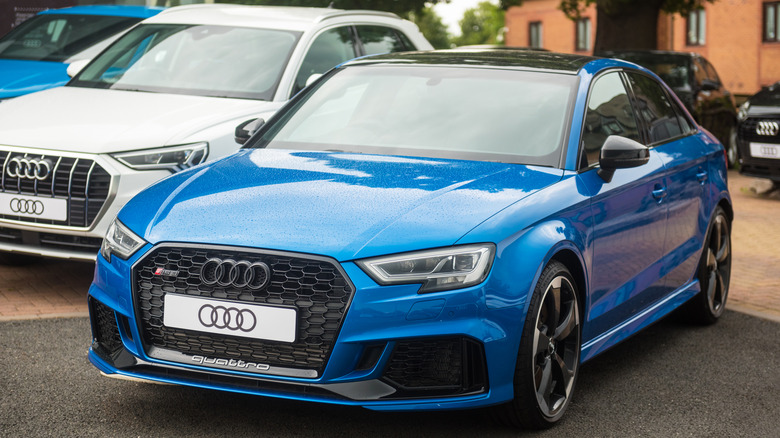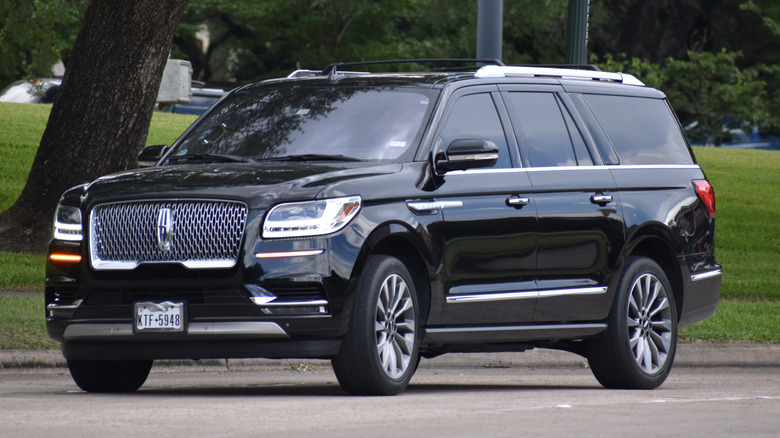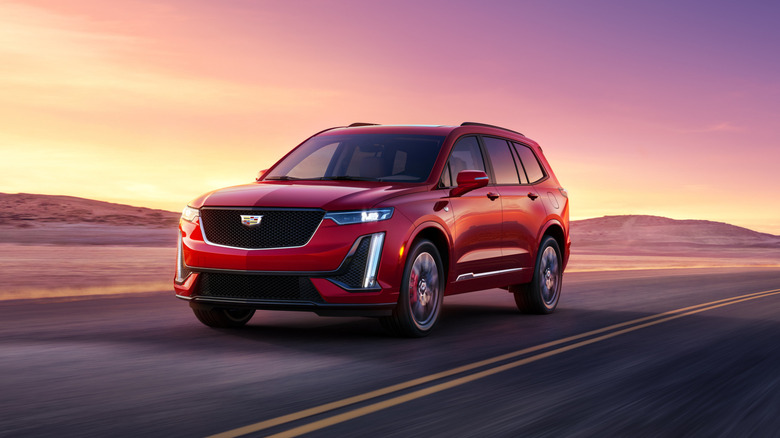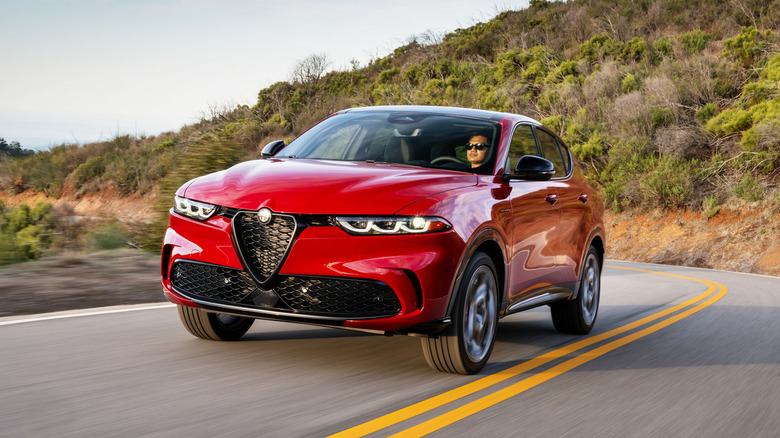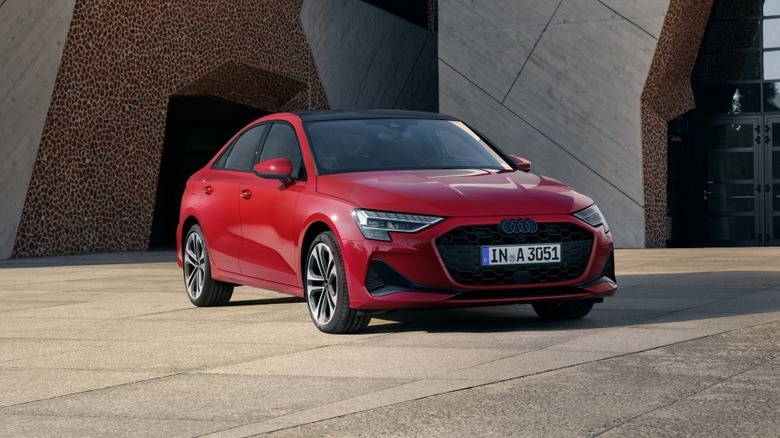5 Luxury Cars That Take Regular Gas
According to AAA, as of July 14, 2025, the average price for a gallon of premium gas, or 91 octane, in California is $4.93. Across the country, that number comes down to $3.98, and drops as low as $3.60 in states like Alabama. It's unlikely that anyone would call any of these fuel costs cheap. For luxury cars like the BMW X7 that require high test, filling up the tank in California would run you more than $100.
Due to the proliferation of high-compression turbocharged engines across the luxury car marketplace, premium fuel requirements have become more common. And that's not just for high-dollar rigs like the X7. Even relatively affordable luxury cars like the Audi A3 demand the good stuff, as of 2025 anyway. Considering regular gas, or 87 octane, has a national average price of $3.15, filling up your tank can vary dramatically depending on fuel requirements. It can also have an impact on performance.
Luxury-leaning Mazda, for example, spells out a 21 horsepower reduction in power for its CX-90 SUV when running on regular gas instead of premium. Whatever car you drive, it's a good idea to stick with the gas specified by the manufacturer, but in the luxury segment, there are few new options that don't require premium.
Fortunately, these five models all manage to fit the luxury bill, while sipping on regular. Keep them in mind when shopping, and your wallet will thank you.
Lincoln Navigator
The Lincoln Navigator, redesigned for 2025, is as luxury as luxo-barges come. It has a $99,995 starting price that balloons to $136,000 for a fully loaded extended-length variant. That includes such frippery as a $2,000 paint job, 24" rims with Radiant Copper highlights, a thumping 28-speaker audio system from Revel, a 48-inch panoramic dash screen, BlueCruise self-driving tech, something called Digital Scent, and so on and so forth.
Powering the Navigator is a twin-turbo 3.5-liter V6 making a heady 440 horsepower and 510 lb-ft of torque. You'd be forgiven for assuming all this power and opulence comes with a premium gas requirement, but that's not the case. The big Lincoln, in fact, runs on regular gas. Now, it remains a pig at the pumps with EPA figures of 15 mpg around town, 22 on the highway, and 17 combined. Filling up the tank on regular is "only" $74 versus $94 if it required 91 octane.
According to the EPA, this translates to $2,850 in annual gasoline costs for the Navigator. For comparison, the equally luxurious Jeep Grand Wagoneer would come with a $3,650 gas station tab at the end of one year. That's $304 per month in gas for the big Jeep, and its larger tank would cost $109 to fill up ($131 in California). Those are big numbers for anyone and serve as a good reminder to find out what kind of gas your luxury car takes before buying.
Cadillac XT6
Cadillac's XT6, a three-row crossover that competes with Audi's Q7, requires some research for those trying to save a buck at the pump. Models fitted with the 2.0-liter turbocharged four-cylinder engine take 91 octane, but Cadillac sells a Chevy-sourced naturally aspirated 3.6-liter V6 variant, which happens to make 75 more horsepower than the four-pot and runs on regular gas.
Based on AAA national average figures, the 19-gallon tank in V6-powered XT6 would cost $60 to fill up with regular gas, a number that bumps to $76 were you to use premium. An Audi Q7, on the other hand, with the 3.0-liter turbocharged V6 powertrain running on 91 would cost $93 to fill. Granted, the Audi's tank is 3.5 gallons larger than the Caddy's, but $33 is still a notable delta. Plus, the Q7 only makes an extra 25 horsepower and the XT6 is plenty luxurious.
With a price range between about $49,000 and $62,000, the Cadillac XT6 offers niceties like a cabin air ionizer, a Bose 14-speaker audio system, a Chassis Damping Control system, Night Vision, Super Cruise hands-free driving, and a panoramic moonroof. Considering the Audi's sticker price starts near where the Cadillac tops out, the XT6 offers a double whammy of value when factoring in its less expensive fuel requirements.
Lexus ES
Lexus makes plenty of luxury cars requiring premium gas, from the RX crossover to the full-size LS sedan, but its ES old-school luxury sedan continues to run on regular. Even better, the entire ES lineup, 250, 350, and 300h takes 87 octane. This is partly due to the ES eschewing the increasingly common forced induction powertrain approach across the luxury segment in favor of an all-naturally aspirated engine lineup.
In the ES350, for example, there is a free-breathing 3.5-liter V6 making 302 hp and 267 lb-ft of torque. Running on regular, the EPA says it'll cost you $51 to fill up and $1,950 in annual gas costs. Interestingly, the BMW 530i, a direct ES competitor, requires premium fuel and only comes with an extra $50 in yearly fuel costs. That's mainly because its more fuel-efficient powertrain earns six more mpg in the combined cycle than the Lexus.
However, both of these luxury cars share a 15.9-gallon gas tank volume and in the BMW that means a $66 bill to fill. Whether the $15 upcharge over the Lexus for this metric is worth it is an entirely personal choice, but if you were to go the hybrid route with a Lexus ES in 300h guise, the annual fuel costs drop to just $1,100, and a fill-up runs only $42. That's a big swing for those who regularly visit the gas station and makes a strong case for finding a luxury car that runs on 87.
Alfa Romeo Tonale
No matter which Alfa Romeo Tonale you go with, this little Italian crossover takes regular gas. In base spec, the 2.0-liter turbocharged inline-4 earns 25 mpg combined, has a 13.5-gallon tank, costs $43 to fill up, and will run you about $2,000 annually in gas costs. The more powerful plug-in hybrid variant, which has a 29-mpg combined fuel efficiency rating and offers 33 miles of gas-free driving, has a smaller tank and associated lower fill-up cost of $36. However, it also shaves $750 off the annual fuel costs of its non-hybrid stablemate.
Aiming at the sporty side of the luxury segment, the Tonale can be fitted with Brembo brakes, adaptive dampers, a Veloce body kit, and 19-inch wheels with the iconic Alfa Romeo five-hole design. There's plenty of luxury too in the form of a Harman Kardon audio system, heated and ventilated front seats, a self-parking system, and the Active Driving Assist almost-hands-free driving tech.
For comparison to the Alfa on the octane front, we give you the Mercedes GLA 250. Versus the non-hybrid Tonale, it earns an extra five mpg in the city, highway, and combined fuel economy cycles. On an annual basis, you'd only be on the hook for an additional $150 versus the Alfa Romeo. However, the GLA's premium fuel requirement means an extra $13 per fill-up on the same-sized tank. It's not as huge a difference as brutes like the Navigator and Grand Wagoneer, but worth keeping in mind.
Audi A3
For the 2025 model year, Audi made a host of changes to its fun and fairly priced A3 sedan, and two are of special note to fuel economy fanatics. The 2.0-liter turbocharged four-cylinder engine now makes an extra 15 lb-ft of torque over the 2024 A3 and quattro AWD has gone from optional to standard. This is seemingly a good thing, but one major downside to this update is that the A3 now demands 91 octane, whereas the 2024 models were happy to run on 87 and FWD versions delivered better fuel economy than their AWD counterparts.
With the 2024 Audi A3, you could drive a FWD model that earns 32 mpg combined, requires $42 to fill up, and costs $1,500 annually at the pumps. On the other hand, the more powerful AWD-only 2025 A3 drops by four mpg in the combined cycle, costs $60 to fill, and sees annual fuel costs jump to $2,200. It's a fairly significant spike in gasoline costs and makes the case for going the lightly used route when shopping the Audi A3.
In either case, you can enjoy features like leather upholstery, triple-zone automatic climate control, real wood trim, and an audio system from Bang & Olufsen in your A3. But regardless of whether you go the brand-new 2025 or nearly-new 2024 route, be aware that the spiced-up S3 and RS3 street-legal rally car require premium gas to deliver their higher levels of performance.
